|

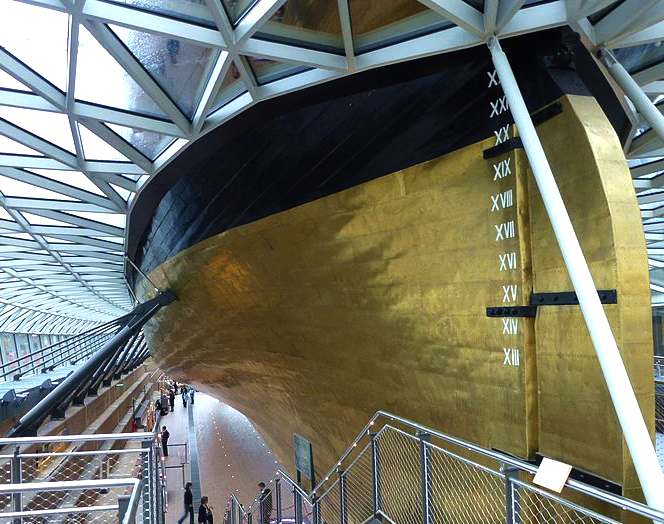
From
stem to stern the Cutty Sark
is beautifully preserved and presented
MUSEUM SHIP &
EXHIBITION
The Cutty Sark
is preserved as a museum ship and has become a popular tourist
attraction. She is part of the 'Core Collection' of the UK's National Historic
Fleet. The Cutty Sark is located near the centre of Greenwich, in south-east London, close
to the National Maritime Museum, the former Greenwich Hospital, and Greenwich Park. She is also a prominent landmark on the route of the London
Marathon. She usually flies signal flags from her ensign halyard reading "JKWS", which is the code representing Cutty Sark in the International Code of Signals, introduced in 1857.
The ship is in the care of the Cutty Sark Trust, whose president, the Duke of
Edinburgh, was instrumental in ensuring her preservation, when he set up the Cutty Sark Society in 1951. The Trust replaced the Society in 2000. She is a Grade I
listed monument and is on the Buildings At Risk Register. The gallery beneath the ship holds the world's largest collection of ships' figureheads, donated to the Society by Sydney Cumbers in 1953.
Cutty Sark station on the Docklands Light Railway is one minute's walk away, with connections to central London and the London Underground. Greenwich Pier is next to the ship, and is served by scheduled river boats from piers in central London. A tourist information office stands to the east of the ship.
FUND
RAISING & REASONING
The exhibition includes an explanation as to how and why the Cuty Sark is being saved as a film presentation re-creating the master's saloon and interactive exhibits about the project.
The design for the renovation project by Grimshaw architects with, during design development stage, newly established Youmeheshe architects and Buro Happold engineers involved raising the ship out of her dry berth using a Kevlar web, allowing visitors to pass under the hull to view it. Unfortunately it was discovered that the proposed web would not follow the reverse curves of the ship's hull which would effectively mask the hull's shape from view. An alternate design for the support of the ship had to be developed; this involved installing a deep steel belt around the hull tied by diagonal steel members passing through the hold to a new steel-reinforced keel. Horizontal tubular steel struts passing through the hold brace the diagonals apart while many of the corroded original hull frames have been doubled.
A new steelwork lower deck of contemporary design incorporating an amphitheatre feature was installed in the main hold while a glass encased lift installed within the ship terminates in a new steel and
glass housing structure on the weather deck. A second new steel and glass box has been installed above the fore hold to enclose a new staircase. Access to the ship is through a new opening cut through the hull below the waterline in the ship's starboard quarter. The new access hole has required the addition of new steel framing. Visitors arriving on board the ship now do so via this entrance, which leads to the lower hold. Maldwin Drummond, Chairman of the Cutty Sark Trust, has explained in Classic Boat magazine's September 2010 issue the need to retain the spirit of the ship and he quotes the ideal that "The visitor should see the ship as though for some unexplained reason the crew had gone ashore". Doubts over the wisdom of Grimshaw's proposals have been raised by many ship conservationists including the Cutty Sark Trust's own engineer Peter Mason.
The project was costed at £25 million when it commenced in 2006 with £11.75 million of this total being provided by a grant from the Heritage Lottery Fund.
Oscar-winning film producer Jerry Bruckheimer aided in the repair and restoration of the Cutty Sark. A collection of photos taken by Bruckheimer went on display in London in November 2007 to help raise money for the Cutty Sark Conservation Project. The exhibition featured more than thirty pictures taken on set during the filming of
Pirates of the Caribbean: At World's End.
In January 2008, the Heritage Lottery Fund awarded the Cutty Sark Trust another £10 million towards the restoration of the ship, meaning that the Trust had now achieved £30 million of the £35 million needed for the completion of the project.
In June 2008, Israeli shipping magnate Sammy Ofer donated the outstanding £3.3 million needed to fully restore the ship although by January 2009 the
Evening Standard reported that the cost had risen further to £40 million creating a new shortfall. In February 2010 the
Daily Telegraph reported the project cost had risen to £46 million with public money now being made available by London Borough of Greenwich to fill the funding gap.
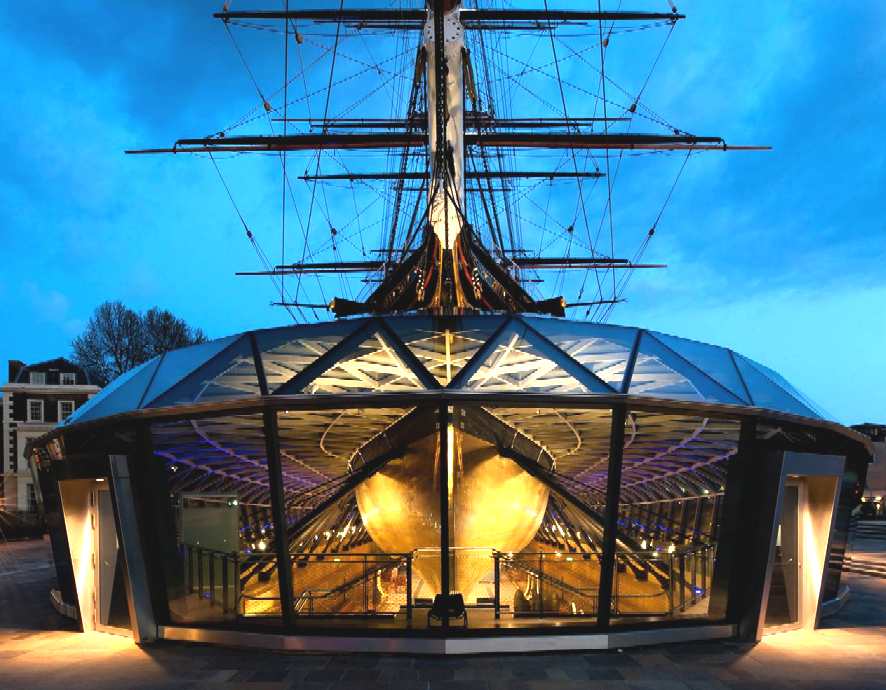
The
exhibition during twilight hours is visually stunning
FIRE DAMAGE, INVESTIGATION & CONCLUSION
Aerial video footage showed extensive damage, but seemed to indicate that the ship had not been destroyed in its entirety. A fire officer present at the scene said in a
BBC interview that when they arrived, there had been "a well-developed fire throughout the ship". The bow section looked to be relatively unscathed and the stern also appeared to have survived without major damage. The fire seemed to have been concentrated in the centre of the ship. The chairman of Cutty Sark Enterprises said after inspecting the site: "The decks are unsalvageable but around 50% of the planking had already been removed; however, the damage is not as bad as originally expected."
As part of the restoration work planned before the fire, it was proposed that the ship be raised three metres, to allow the construction of a state of the art museum space beneath. This would allow visitors to view her from below.
There was criticism of the policies of the Cutty Sark Trust and its stance that the most important thing was to preserve as much as possible of the original fabric. Proponents of making her fit to go to sea advocated that the fire repairs be done in such a manner to enable her to do so. However, the state of the timbers, especially the keel, and the fact that a hole had been cut through the hull in the 1950s for an access door, made this difficult. Also, the Cutty Sark Trust claimed that under five percent of the original fabric was lost in the fire, as the decks which were destroyed were non-original additions. The restoration work was criticised by The Victorian Society saying that the needs of the corporate hospitality market were put ahead of the preservation of the historic fabric of the ship. Building Design magazine awarded the project its Carbuncle Cup for the worst new building completed in 2012 saying 'The scheme’s myriad failings stem from one calamitous choice: the decision to hoick the 154-year-old clipper close to three metres into the air on canted steel props.
On 30 September 2008, the London Fire Brigade announced the conclusion of the investigation into the fire at a press conference at New Scotland Yard. The painstaking investigation was conducted by the Fire Brigade, along with London's Metropolitan Police Service, Forensic Science Services, and electrical examination experts Dr. Burgoyne's & Partners. They said that the most likely cause was the failure of an industrial vacuum cleaner that may have been left switched on over the weekend before the fire started. The report revealed no evidence the ship was subjected to arson attack and concluded the fire started accidentally.
Physical evidence and CCTV footage of the fire showed that it probably started towards the stern of the ship on the lower deck. All electrical equipment on board was examined and it was determined that an industrial vacuum cleaner in this area was normally running continuously to suck up dust and particles from work going on to break up concrete within the ship. No one working on the ship had responsibility to ensure all equipment was turned off at the end of each day, and no one recalled switching off the equipment on the Friday in question. The vacuum cleaner has three motors inside and after the fire one was found to be burned out in a manner which suggested it had failed while operating. This was not conclusive evidence, however, because the motor might previously have failed in service without causing a fire, and gone unnoticed because the other two motors had continued to function. Tests on similar cleaners showed they had no thermal cutout devices and while they could run safely indefinitely if filters inside were clear, if the air flow through the cleaner was blocked then it would eventually overheat and could catch fire. This might occur if the cleaner was full of dust and debris. The cleaner had failed previously and two motors had been replaced.
On the basis of witness evidence, the joint investigation team considered it unlikely that the fire was caused by the hot work
(welding) that was being carried out as part of the renovation or by carelessly discarded smokers' materials. No one visited this part of the ship since work stopped on Friday evening, and it was considered unlikely that a fire could have smouldered all weekend before finally breaking out Monday morning. However, it was discovered that although all hot work was supposed to be recorded and someone was supposed to check afterwards to ensure no fires, there was no record that such checks had ever been made, and on at least one occasion hot work had been conducted with no records made.
The ship was patrolled by two security guards, both of whom were supposed to patrol independently at least once an hour, or once every two hours later in the night, one being primarily responsible for the visitor pavilion and one the dock. The guards were required to keep a log of their patrols, but after the fire the relevant page was found to be missing from the book. It was later found, already filled in reporting uneventful patrols of the site up to 7 am in the morning when the guards would have gone off duty. The alarm was raised when one of the guards called the fire brigade; before this the two reported that they had smelled burning plastic and had been investigating to try to determine its source.
A carpenter had visited the site on Sunday to collect some tools, but after 20 minutes attempting to contact a security guard to let him in, had climbed the fence, collected his tools and climbed out again. The carpenter reported that he had heard machinery operating towards the stern of the ship, but it was not clear whether this might have been the site diesel generator which ran at all times.
The ship was fitted with a temporary fire alarm system but it was unclear whether this had operated. A separate alarm within the pavilion did sound when smoke and heat reached that area, but the guards reported no ringing alarm before the fire was seen. Investigation afterwards discovered a faulty relay in the alarm panel which failed to switch power to the siren circuits when an alarm was triggered. However, the panel also contained a failed fuse in one siren circuit which suggested that the siren had activated but the fire shorted it out, and this might have also caused the relay to fail. The failed relay would have shut off power to the second siren circuit. Statements from workers suggested that weekly tests of the alarm system had not been carried out.

The Cutty Sark
undergoing restoration
NEWS
ITEM - Monday, 21 May
2007
Blaze
ravages historic Cutty Sark
I
visited this amazing ship in the summer of 2005, as part of a river cruise
and museum tour with my girlfriend. It is sad to think that while
undergoing much needed restoration works this tragedy occurred. Two
hours after a fire ripped through the hull of the Cutty Sark, the smell of
burning timber lingered on the morning air as fire crews continued to soak
the boat's decks and hull using pressure hoses.
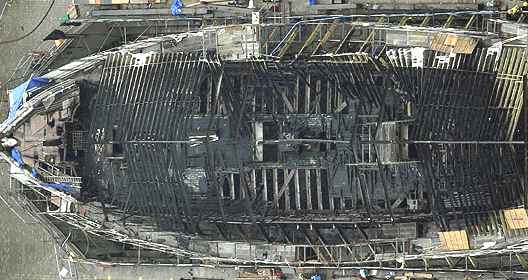
The Cutty Sark's fire damaged hull 21 May 2007 aerial photo
The
blaze was brought under control quickly.
Emergency
services received a call at 0446 BST from a member of the public who said
the Cutty Sark was ablaze.
The
138-year-old tea clipper lies just yards from the Thames in the heart of
Maritime Greenwich, a World Heritage Site. Beside it is the Royal Naval
College, Sir Christopher Wren's great baroque masterpiece of English
architecture.
The
fire is a major blow to a £25m renovation project to save the ship, which
has been under way since November 2006.
'Extremely
sad'
The
project to transform the interior and setting of the ship was about a
quarter of the way in and thankfully 50% of the ship's planks, the mast,
deck houses and captain's cabin had been removed to storage in south-east
London.
The
fire swept through the entire remaining hull of the ship, which had been
covered by a temporary roof, and the skeleton has suffered substantial
damage.
"The
boat was built for the China tea service - to be able to smell the burning
timber and rope is extremely sad," Richard Doughty, project director
and chief executive of the Cutty Sark Trust, told the BBC News website.
"The
tragedy is you can't remake the fabric of the boat - these are timbers
that were growing during the Battle of Agincourt [in 1415]. History itself
has been lost." The boat has three decks and it appears two have
suffered substantial damage. "It's a setback on many levels,"
said Mr Doughty.
The
renovation project was to have been completed in the summer of 2008. It
had received £13m from the Heritage Lottery foundation and almost £6m
from corporate and private donations, but there was still a £7m gap to
close, according to Mr Doughty.
He
said one of the first things that needed to be done was to assess how much
of the wrought iron skeleton had been damaged. "The
principal significance of the ship is its shape," he said. "This
is formed by the iron frames. If they have been seriously damaged, it's
going to be very hard to conserve the ship in the way we had
planned."
"I
have been planning this for six years - it was the next chapter in the
history of the most famous ship in the world. The renovation programme has
been shot to pieces." Mr Doughty described the ship as the epitome of
speed under sail.
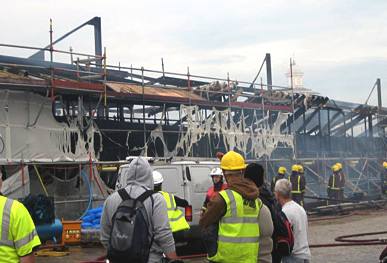
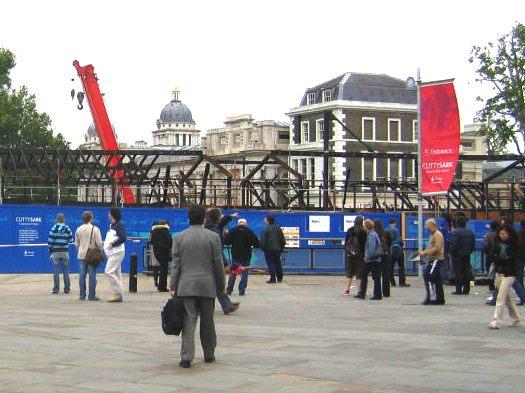
The Cutty Sark's fire crews tending hull 21 May 2007
'Needed
money'
Christ
Livett, chairman of the Cutty Sark Enterprises, which was carrying out the
restoration work, said the damage did not appear to be as bad as they
first thought.
He
told the media it was lucky so much of the ship had been removed. "It
is salvageable," he said. "The ship has been through many
things. We are devastated, lots of people worked hard on the
project."
Mr
Livett added the blaze had made them more determined to complete the
project to restore the much-loved clipper to her former glory and appealed
to the public to help pay for the damage.
"The
Cutty Sark has always needed money
since the day she was built - even more so today," he added. "The
old girl needs more help than ever she did do in the past."
Renovation
project manager Joseph James, of management consultant Hornagold &
Hills, also told the BBC News website the ship's timbers would be
salvageable.
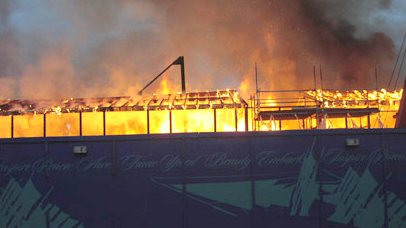
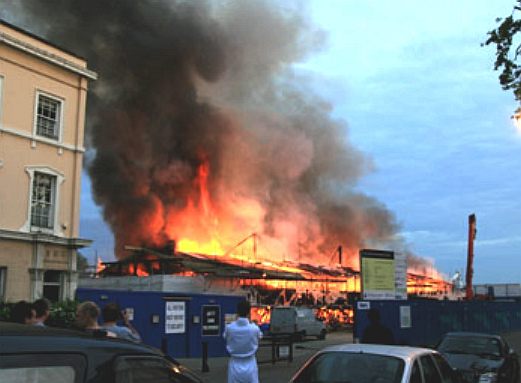
Cutty
Sark on
fire May 21 2007
A fire which swept through the famous 19th Century ship Cutty Sark may
have been started deliberately, police say.
The
vessel, which was undergoing a £25m
restoration, is kept in a dry dock at Greenwich in south-east London. Police
are analysing CCTV images which are thought to show people in the area
shortly before the fire started.
A
Cutty Sark Trust spokesman said much of the ship had been removed for
restoration and the damage could have been worse. Half the planking and
the masts had been taken away as part of the project.
Chris
Livett, chairman of Cutty Sark Enterprises which is repairing the clipper,
said at the scene: "From where I stand there is not a huge amount of
damage to the planking that was left on. "There are pockets of
charred planking and some have gone, but it doesn't look as bad as first
envisaged."
The
chief executive of the charitable Cutty Sark Trust, Richard Doughty, said:
"What is special about Cutty Sark is the timbers, the iron frames
that went to the South China Seas, and to think that that is threatened in
any way is unbelievable, it's an unimaginable shock."
Following
an inspection of the site on Monday afternoon, Mr Doughty said:
"Buckling of the hull remains a big fear but until we do the
measurements we are not going to know. "With my naked eye, as far as
I have been able to see, the structure of the ship seems to be
intact."
Insp
Bruce Middlemiss said detectives were looking into the possibility that
the fire had been started deliberately.
Special
history
Firefighters
were called to the scene at 0445 BST and the flames were put out by 0700
BST.
An
area around the 138-year-old tea clipper had to be evacuated during the
blaze.
"The
cause of the fire is now under investigation by London Fire Brigade and
the Metropolitan Police," a London Fire Brigade spokesman said.
A
number of witnesses have already come forward and the police are urging
anyone else who may have been in the area to contact them. A silver
car was seen leaving the scene but police said there is nothing at this
stage to link it to the fire.

Greenwich
Council leader
councillor Chris Roberts said: "This is a devastating blow for what
is a truly iconic symbol of Greenwich across the world. "The Cutty
Sark has a unique and special history, which helps to draw millions of
visitors to Greenwich every year."
The
Cutty Sark left London on her maiden voyage on 16 February 1870, sailing
around The Cape of Good Hope to Shanghai in three-and-a-half months. She
made eight journeys to China as part
of the tea trade until steam ships replaced
sail on the high seas.
The
ship was later used for training naval cadets during World
War II, and in 1951 was moored in London for the Festival of Britain.
Shortly afterwards, she was acquired by the Cutty Sark Society.
The
ship was undergoing conservation work because sea salt had accelerated the
corrosion of her iron framework. Dr Eric
Kentley, curatorial consultant to
the Cutty Sark Trust, said of the ship: "It can be saved. It's
certainly not completely devastated.
"We
will put her back together - but it's going to take much, much longer and
a lot more money than we originally thought."
Visit
London's chief executive James Bidwell said: "The ship's need for
vital conservation has put it in the public eye recently and we can only
hope that this terrible fire will redouble all our efforts to preserve
this wonderful part of London's heritage."
The
Duke of Edinburgh
is due to visit the Cutty Sark on Tuesday. Culture Secretary Tessa Jowell
inspected the remains on Monday afternoon. The Cutty Sark Trust is
appealing for funds to help repair the fire damage and complete the
restoration.
HISTORY
Ships
like the Cutty Sark were built to cross the Atlantic and
Pacific Oceans at great speed. But she was
overtaken by the advent of steam and the opening of the
Panama Canal. Its final voyage was in
1938. The Cutty Sark is now a permanent exhibition
at Greenwich, London, where a trust has been set up to
restore her at an estimated £10M.
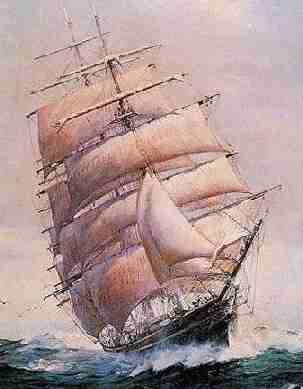
The Cutty Sark
On
the afternoon of Monday, 22nd November, 1869, a
beautiful little clipper ship displacing 963 tons was
launched from Scott and Linton's shipyard at Dumbarton,
on the Clyde. She bcarried a name that was to become
famous throughout the world and was destined to win a
place in the hearts of British seamen second only to
Nelson's immortal Victory. Her name was
the Cutty Sark.
The
Cutty Sark was designed by Hercules Linton as a
composite built extreme clipper ship for "Old White
Hat" Jock Willis of London. She sailed on the
China Tea Trade for a couple of seasons without
distinguishing herself and lost her rudder in 1872 off
the Cape of Good Hope when racing Thermopylae for London
with the first tea.
She
was moved over to the Australian wool trade when the tea
trade was taken over by the steam ships. Here she proved
to be a regularly fast sailer. But was sold to the
Portuguese in 1895 and served for many year's as the
training ship Fereirra. Rerigged as a barquentine after
having been dismasted in a gale off the Cape of Good
Hope in May 1916 and renamed Mario do Ambaro.
Then
in 1922 she was purchased by Capt. Dowman and restored
for use as a stationary training ship, first at Falmouth
then later in 1938 she was moved to The Thames where she
remained until 1949 after which she was permanently
dry-docked at Greenwich
as a museum ship.
Her
registered measurements were as follows:
-
gross
tons - 963,
net tons - 921,
length - 212 feet 5 inches
breadth - 36 feet
depth - 21 feet
moulded depth - 22 feet 5 inches
Built
in 1869 at Dumbarton on the River Clyde
Designed
by Hercules Linton
First
voyage February 1870
Main
mast stood 152ft (46.3m) above the deck
The extreme length of bowsprit and jib-booms was 60
feet, the length of mainmast from deck to truck
145 feet 9 inches
,
mainyard 78 feet and spanker-boom 280 feet
The Cutty Sark was by far the most powerful of the tea
clippers. Find
out more at the Cutty
Sark web site.
MAST, NUTS & BOLTS
The original mast specifications as laid down by the ships designer still exist and are listed below as "tea rig". This arrangement was used during the ship's time on the tea trade route, where it was necessary to maximise the area of sail to get the greatest possible propulsion when the ship might be becalmed in the doldrums. For the route to Australia it was not necessary to carry such a large area of sail and the masts and yards were reduced. The trade winds required great strength in masts, but the wind could best be captured by relatively small, high sails. A smaller rig also represented a saving in maintenance costs. Each of the three masts (fore, main and mizzen) is in three overlapping sections.
|
Mast
heights above deck in metres |
|
Yard
lengths in metres |
|
|
|
|
|
Tea rig
|
Sydney
|
|
Foretop
|
18.8
|
16.5
|
|
Topgallant
|
29.8
|
24.3
|
|
Royal
|
39.6
|
35.4
|
|
Maintop
|
19.8
|
16.9
|
|
Topgallant
|
31.9
|
22.8
|
|
Royal
|
|
36.3
|
|
Skysail
|
44.5
|
|
|
Mizzentop
|
17.0
|
14.8
|
|
Topgallant
|
25.7
|
22.8
|
|
Royal
|
33.2
|
31.7
|
|
|
|
|
Tea rig
|
Sydney
|
|
Fore course
|
23.8
|
21.0
|
|
Lowertopsail
|
20.7
|
16.8
|
|
Uppertopsail
|
19.5
|
14.6
|
|
Topgallant
|
14.6
|
11.5
|
|
Royal
|
11.6
|
9.4
|
|
Main course
|
23.8
|
21.6
|
|
Lowertopsail
|
20.7
|
18.5
|
|
Uppertopsail
|
19.5
|
16.8
|
|
Topgallant
|
14.6
|
14.2
|
|
Royal
|
11.6
|
10.4
|
|
Skysail
|
10.4
|
|
|
Mizzen course
|
18.3
|
17.4
|
|
Lowertopsail
|
16.5
|
14.9
|
|
Uppertopsail
|
14.6
|
13.4
|
|
Topgallant
|
11.9
|
11.0
|
|
Royal
|
10.1
|
8.2
|
|
Spanker
|
15.8
|
14.1
|
|
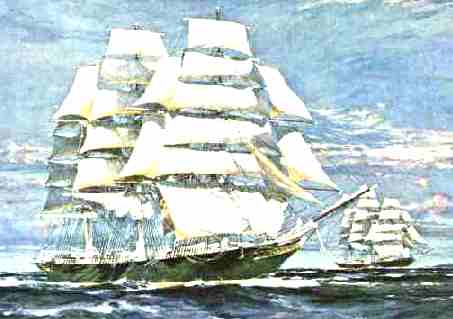
Cutty Sark racing
Thermopylae
The
Thermopylae was built at the shipyard of Walter Hood
& Co., Aberdeen, in 1868 for George Thompson's
"White Star Line". She measured 212.0 ft x
36.0 ft x 20.9 ft and 948 tons net. Designed as an
extreme clipper for the China tea trade and rigged as a
three-masted ship. On her maiden voyage
Thermopylae made a record crossing from Gravesend to
Melbourne in 63 days, on her continued voyage to
Shanghai she set another record between those two ports.
In 1872
Thermopylae left Shanghai with a cargo of tea for London
in company with the London clipper Cutty Sark.
After racing each other for two weeks Cutty Sark lost
her rudder after having passed the Sunda Straits.
Thermopylae finally arrived in London only seven days
ahead of her rival.
Sold to
Canadian owners in 1890 who cut her down her rig to that
of a barque. In 1895 Thermopylae was also sold to
the Portuguese Government who converted her to a
training ship and renamed her Pedro Nunes. Her end
came in 1906 when she was torpedoed at sea by units of
the Portuguese Navy.
Building
The
Clyde-built Cutty Sark was, in 1869, one of the last sailing
clippers to be
built. She is preserved in dry dock at Greenwich in London, but was
damaged in a fire on 21 May 2007 while undergoing extensive restoration.
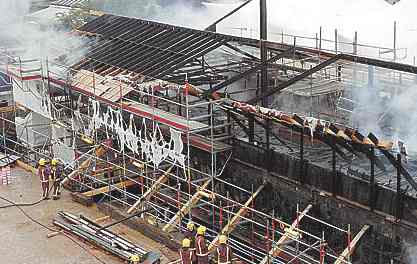
Cutty Sark emergency fire services crew survey damage
The
ship is named after the fictional character "Cutty-sark" (Scots:
a short chemise or undergarment), an erotic dancing witch in Robert Burns'
1791 comic poem Tam o' Shanter. She was designed by Hercules Linton
and built in 1869 at Dumbarton, Scotland, by the firm of Scott &
Linton, for Captain John "Jock" "White Hat" Willis,
and launched November 23 of that
year.
The
Cutty Sark was destined for the tea trade, then an intensely
competitive race across the globe from China
to London, with immense profits to the ship to arrive with the first tea
of the year. However, she did not distinguish herself; in the most famous
race, against Thermopylae in 1872, both ships left Shanghai
together on June 18,
but two weeks later Cutty Sark lost her rudder after passing
through the Sunda Strait, and arrived in London on October 18, a week
after Thermopylae, a total passage of 122 days. Her legendary
reputation is supported by the fact that her captain chose to continue
this race with an improvised rudder instead of putting into port for a
replacement, yet was only beaten by one week.
In
the end, clippers lost out to steamships, which could pass through the
recently-opened Suez Canal
and deliver goods more reliably, if not quite so quickly, which as it
turned out was better for business. Cutty Sark was then used on the
Australian wool trade. Under the
respected Captain Richard Woodget, she did very well, posting
Australia-to-Britain times of as little as 67 days. Her best run, 360
nautical miles (666 km) in 24 hours (an average 15kt, 27.75 km/h), was
said to have been the fastest of any ship of her size.
In
1895 Willis sold her to the Portuguese
firm Ferreira and she was renamed Ferreira after the firm,
although her crews referred to her as Pequena Camisola
("little shirt", a straight translation of the Scots
"cutty sark"). In 1916 she was dismasted off the Cape of Good
Hope, sold, re-rigged in Cape Town as a barquentine, and renamed Maria
do Amparo. In 1922 she was bought by Captain Wilfred Dowman, who
restored her to her original appearance and used her as a stationary
training ship. In 1954 she was dry-docked at Greenwich.
Cutty
Sark is also preserved in
literature in Hart Crane's long poem "The Bridge" which was
published in 1930.
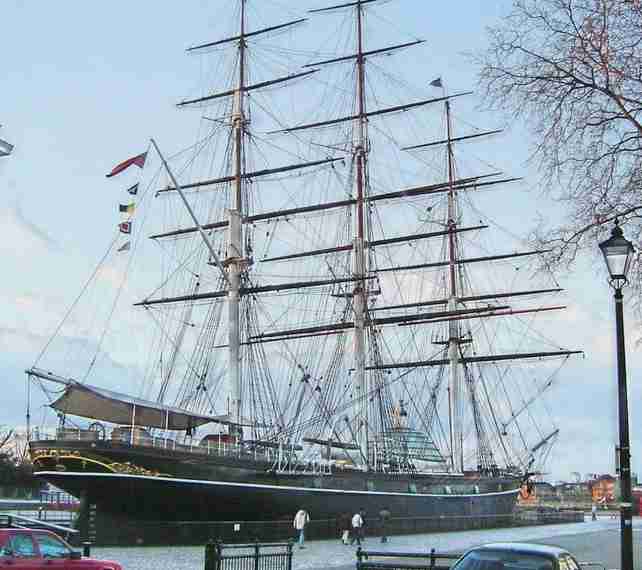
Cutty
Sark, January 2005
Today
The
Cutty Sark is today preserved as a museum ship and popular tourist
attraction. She is located near the centre of Greenwich, in south-east London,
close aboard the National Maritime Museum, the former Greenwich Hospital,
and Greenwich Park. She is also a prominent landmark on the route of the London
Marathon. She flies signal flags on her ensign staff reading "JKWS",
which is the code representing Cutty Sark in the International Code of
Signals, introduced in 1857.
Cutty
Sark inspired the name of a brand
of whisky. An
image of the ship appears on the label, and the maker formerly sponsored
the Cutty Sark Tall Ships' Race. She also inspired the name of the
Saunders Roe Cutty Sark flying boat. The Life and Times of Scrooge
McDuck part three-and-a-half: The Cowboy Captain of the Cutty Sark by
Don Rosa features the ship herself. In the award winning science fiction
novel Blue Mars, by Kim Stanley Robinson, the Cutty Sark is portrayed
sailing on the oceans of a post global warming earth.
Cutty
Sark is a Grade
I listed monument and is on the Buildings At Risk Register.
Cutty
Sark station on the Docklands Light Railway is one minute's walk away,
with connections to central London and the London Underground. Greenwich
Pier is next to the ship, and is served by scheduled river boats from
piers in central London. A tourist information office stands to the east
of the ship.
Conservation
and fire
On
21 May 2007 the Cutty Sark, which had been closed and partly
dismantled for conservation work, caught fire.
The
ship was reported by the BBC
to be completely ablaze. The extent of the damage is not yet known but
there is concern that it may have affected the framework of the ship. The
fire was reported to the fire service at 4:46 a.m. British Summer Time by
members of the public. A representative of London
Fire Brigade said at 7:09 a.m. that the fire was well under control and
that damage was extensive but until the experts could make a full damage
assessment survey, it was unknown just how much has been lost. The fire
was declared by a journalist on site to have been out at 07:21 a.m., with
most of the wooden structure in the centre having been lost.
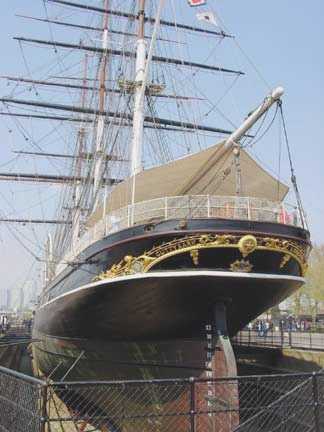
Cutty
Sark,
stern and rudder
In
an interview with the chief executive of the Cutty Sark Trust it was
revealed that at least half of the "fabric" (timbers,
etc) of the ship is not on the site as it is being dismantled for the
preservation work, and that they are most worried about the iron framework
to which the fabric is attached.
Aerial
video footage at 7:22 a.m. showed extensive damage but seems to indicate
that the ship has not been destroyed in its entirety. A fire officer
present at the scene said in a BBC interview that when they arrived, there
was "a well-developed fire throughout the ship". The bow section
looks to be relatively unscathed and the stern also appears to have
survived without major damage. The fire seems to have been concentrated in
the centre of the ship.
The
Chairman of Cutty Sark Enterprises who has inspected the site said at
around 8:35 a.m., "The decks are unsalvageable but around 50% of the
planking had already been removed; however, the damage is not as bad as
originally expected." It has already been stated that the ship
can be restored, the damage being less than originally thought. Up to half
of the original material is currently being stored off-site during
restoration. The chief executive of the Cutty Sark Trust
did not know how much extra the ship would cost to restore, but estimated
it at an extra £5-10 million, bringing the total cost of the ship's
restoration to £30-35
million.
It
has also been officially stated that, once restored, the ship will still
predominantly be the original Cutty Sark although it is obvious
that material lost in the blaze will have to be re-created. The bow was
predominantly undamaged, the stern appears fairly intact, and the rest,
whilst damaged, should at least be in part repairable. As such the ship
will still have a majority of the original parts and will still be the
"Cutty Sark". (The question of whether or not the ship is
the same ship after repair is is an example of the ancient Ship of Theseus
paradox).
The
cause of the fire is currently unknown but is being treated as
"suspicious" by the authorities.
As
part of the restoration work planned before the fire, the ship was
proposed to be raised three metres out of her dry dock, to allow the
construction of a state of the art museum space beneath. This would allow
visitors will be able to admire her sleek shape from below.
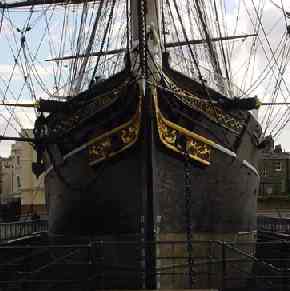
The Cutty Sark at Greenwich, London
2005
DESIGN
& BUILD - THE QUEST FOR SPEED
The Cutty Sark was ordered by John "Jock" "White Hat" Willis who operated a shipping company founded by his father. The company had a fleet of clippers and regularly took part in the tea trade from China to Britain. Speed is a clear advantage to a merchant ship, but it also created prestige for the owners: the tea race was widely reported in newspapers and had become a national sporting event with money bet on the winning ship. In earlier years Willis had commanded his father's ships at a time when American-designed ships were the fastest in the tea trade, and then had owned British-designed ships, which were amongst the best available in the world but had never won the tea race. In 1868 the brand new Aberdeen-built clipper Thermopylae set a record time of 61 days port to port on her maiden voyage from London to Melbourne and it was this design that Willis set out to better.
It is uncertain how the hull shape was chosen. Willis chose Hercules Linton to design and build the ship but Willis already possessed another ship, The Tweed, which he considered to have exceptional performance. The Tweed (originally Punjaub) was a frigate designed by Oliver Lang based on the lines of an old French frigate, built in Bombay for the East India company as a combination sail/paddle steamer. She and a sister ship were purchased by Willis, who promptly sold the second ship plus engines from The Tweed for more than he paid for both. The Tweed was then lengthened and operated as a fast sailing vessel, but was considered too big for the tea runs. Willis also commissioned two all-iron clippers with designs based upon Tweed, Hallowe'en and Blackadder. Linton was taken to view the ship in dry dock.
In particular, Willis considered that the bow shape of The Tweed was responsible for its notable performance, and this seems to have been adopted for Cutty Sark. Linton, however, felt that the stern was too barrel-shaped and so gave Cutty Sark a squarer stern with less tumblehome. The broader stern increased the buoyancy of the rear of the ship, making it lift more in heavy seas so it was less likely waves would break over the stern, and over the helmsman at the wheel. The square bilge was carried forward through the centre of the ship. In the matter of masts Cutty Sark also followed the design of The Tweed, with similar good rake and with the foremast on both ships being placed further back than was usual.
A contract for Cutty Sark's construction was signed on 1 February 1869 with the firm of Scott & Linton, which had only been formed in May 1868. Their shipyard was at Dumbarton on the River Leven on a site previously occupied by shipbuilders William Denny & Brothers. The contract required the ship to be completed within six months at a contracted price of £17 per ton and maximum weight of 950 tons. This was a very competitive price for an experimental, state of the art ship, for a customer requiring the highest standards. Payment would be made in seven installments as the ship progressed, but with a penalty of £5 for every day the ship was late. The ship was to be built to Lloyd's A1 standard and her construction was supervised on behalf of Willis by captain George Moodie, who would command her when completed. Construction delays occurred when the Lloyd's inspectors required additional strengthening in the ship.
Work on the ship was suspended when Scott and Linton ran out of money to pay for further work. Rather than simply liquidate the company, an arrangement was made for Denny's to take over the contract and complete the ship, which was finally launched on 22 November 1869 by Captain Moodie's wife. The ship was moved to Denny's yard to have her masts fitted, and then on 20 December towed downriver to Greenock to have her running rigging installed. In the event, completing the ship meant the company's creditors were owed even more money than when work had first been halted.
Broadly, the parts of the ship visible above the waterline were constructed from East India teak, while American rock elm was used for the ship's bottom. The keel (16.5 x 15 inches) had on either side a garboard strake (11 x 12 inches) and then 6-inch planking decreasing to 4.75 inches at 1/5 the depth of the hold. Teak planking began at approximately the level of the bilge stringer. All the external timbers were secured by Muntz metal (brass) bolts to the internal iron frame and the hull covered by Muntz sheeting up to the 18-foot depth mark. The stem (15 x 15 inches) and sternpost (16.5 x 15 inches) were of teak while the rudder was of English oak. The keel was replaced in the 1920s with one constructed from 15 inches (38 cm) pitch
pine. The deck was made of 3.5-inch thick teak while the 'tween deck was 3-inch yellow pine. Her length was 212 feet 5 inches (64.74 m) with a draft of 21 feet (6.40 m) and a deadweight of 921 tons.
The maximum logged speed for Cutty Sark was 17.5 knots. The speed of a sailing ship is not so straightforward as a steam ship, as winds vary and a ship must tack when heading into the wind, both requiring the crew to make constant adjustments to sails, so her speed also depended on the skill of her captain and crew. Her greatest recorded distance in 24 hours was 363 nautical miles (NM) (averaging 15 knots), although she recorded 2163 miles in six days, which given the weather over the whole period implied she had achieved over 370 NM some days. By comparison, Thermopylae's best recorded 24-hour distance was 358 NM. Cutty Sark was considered to have the edge in a heavier wind, and Thermopylae in a lighter one.
The ship was named after Cutty Sark, the nickname of the witch Nannie Dee in Robert Burns' 1791 poem Tam o' Shanter. The ship's figurehead, the original carved by Robert Hellyer of Blackwall, shows Nannie Dee in a stark white carving of a bare-breasted woman with long black hair holding a grey horse's tail in her hand. In the poem she wore a linen sark (Scots: a short chemise or undergarment), that she had been given as a child, which explains why it was cutty, or in other words far too short. The erotic sight of her dancing in such a short undergarment caused Tam to cry out "Weel done, Cutty-sark", which subsequently became a well known catchphrase. Originally, carvings by Hellyer of the other scantily clad witches followed behind the figurehead along the bow, but these were removed by Willis in deference to 'good taste'. Tam O'Shanter riding Meg was to be seen along the ship's quarter. The motto, Where there's a Willis away, was inscribed along the taffrail. The Tweed, which acted as a model for much of the ship which followed her, had a figurehead depicting Tam o'Shanter.
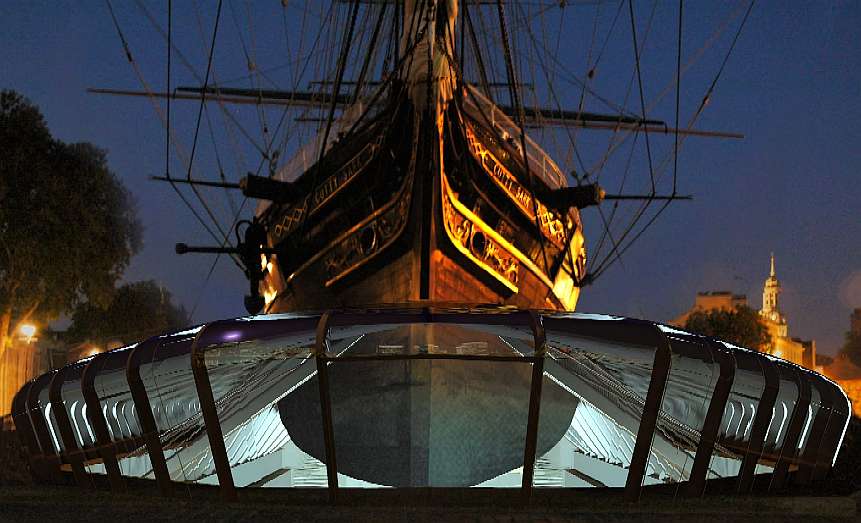
ALL
THE TEA IN CHINA
Cutty Sark was destined for the tea trade, then an intensely competitive race across the globe from China to London, with a substantial bonus to the ship that arrived with the first tea of the year. Her first round trip voyage under captain George Moodie began 16 February 1870 from London with a cargo of wine, spirits and beer bound for Shanghai. The return journey with 1450 tons of tea from Shanghai began 25 June, arriving 13 October in London via the Cape of Good Hope. The ship completed eight round trip annual journeys, but the Suez Canal had opened to shipping in 1869 just as Cutty Sark was being launched. In the end, of course, clippers lost out to steamships, which could use the shorter route through the Canal and deliver goods more reliably, if not quite so quickly, which proved to be better business. Clippers were designed to make best use of the strong trade winds around the African coast route and could not use the shorter route through the canal and Red Sea.
The most famous race against Thermopylae occurred in 1872, the two ships leaving Shanghai together on 18 June. Two weeks later Cutty Sark had built up a lead of some 400 miles, but then lost her rudder in a heavy gale after passing through the Sunda Strait. John Willis' brother was on board the ship and ordered Moodie to put into Cape Town for repairs. Moodie refused, and instead the ship's carpenter Henry Henderson constructed a new rudder from spare timbers and iron. This took six days, working in gales and heavy seas which meant the men were tossed about as they worked and the brazier used to heat the metal for working was spilled out, burning the captain's son. The ship finally arrived in London on 18 October a week after Thermopylae, a total passage of 122 days. The captain and crew were commended for their performance and Henderson received a £50 bonus for his work. This was the closest Cutty Sark came to being first ship home but it was Moodie's last trip as her captain and he transferred to steamships, being replaced by Captain F. W. Moore.
Moore remained captain only for one round trip to China, taking 117 days for the return trip. This was 14 days longer than Thermopylae and 27 days longer than achieved by the iron ship Hallowe'en a few months later. Captain W. E. Tiptaft assumed command in 1873 achieving 118 days on his first return trip, but after the ship had to travel 600 miles up the Yangtze River in search of a cargo. Steamships were now taking most of the tea. The following year the return journey took 122 days, but on the outward journey Cutty Sark set a record time of 73 days from London to Sydney. In November 1877 the ship was anchored off Deal in the English Channel along with 60 other ships, waiting out a great storm. The anchor failed to hold and Cutty Sark was blown through the ships damaging two others before grounding on a mud bank. Fortunately she was pulled clear by the tug Macgregor before too much damage was caused and she was towed to the Thames for repairs.
In December 1877 the ship sailed from London to Sydney, where she took on coal for Shanghai, arriving there in April. However, the ship was unable to find any cargo of tea for a return trip to London; the days of the tea race were over. The master, Captain Tiptaft died in October while still in Shanghai and was replaced by the first mate, James Wallace. The ship now had to take different cargoes around the world, including coal, jute, castor oil and tea to Australia.
In 1880 an incident occurred on board during which the First Mate Sidney Smith killed seaman John Francis. Smith was allowed to leave the ship at Anjer by captain Wallace, causing the crew to cease work in protest. Wallace continued the voyage with six apprentices and four tradesmen but became becalmed in the Java Sea for three days. In desperation as matters moved from bad to worse, he committed suicide by jumping overboard and disappeared. He was replaced as Master by William Bruce, who proved to be a drunken incompetent who claimed pay for non-existent crewmen and managed to set sail with inadequate provisions, resulting in the crew starving. An inquiry in
New York in April 1882 resulted in the Captain and Mate being suspended and replaced By Captain Moore, previously of the
Blackadder.
PULLING
THE WOOL and THE AGE OF STEAM
In December 1883, Cutty Sark departed Newcastle, New South Wales with 4,289 bales of wool and 12 casks of tallow, arriving back in London in just 83 days. This was 25 days faster than her nearest rival that year and heralded the start of a new career taking Australian wool to Britain in time to catch the January wool sales. In 1885 Richard Woodget was appointed Captain on a salary of £186 per year and continued to improve on the fastest trip record, achieving 77 days on his first outward trip and 73 days returning to Britain from Australia. He achieved this by taking a more southerly route than previously, to catch the strongest winds in the Roaring Forties despite having to face icebergs, gales and storms whipped up by the winds he sought. Cutty Sark was the fastest ship on the wool trade for ten years. In July 1889 the log of the modern passenger steam ship RMS Britannia recorded that when steaming at 15-16 knots she was overtaken in the night by a sailing ship doing 17 knots, which proved to be Cutty Sark.
Eventually steamships began to dominate the wool trade too and it ceased to be profitable for a sailing ship. In 1895 Jock Willis sold Cutty Sark to the Portuguese firm Ferreira for £2,100 and she was renamed Ferreira after the firm. Her crews referred to her as Pequena Camisola ("little shirt", a straight translation of the Scots "cutty sark"). The ship traded various cargoes between Portugal, Rio, New Orleans, Mozambique, Angola, and Britain. In May 1916 she was dismasted off the Cape of Good Hope because of the rolling of the ship in bad weather and had to be towed into Table Bay off Cape Town. The war meant that it was impossible to obtain suitable materials to replace the masts so she was re-rigged over 18 months to a barquentine sail arrangement.
In 1922 Ferreira was the last clipper operating anywhere in the world. Caught in a storm in the English channel she put into Falmouth harbour where she was spotted by retired windjammer captain Wilfred Dowman, of Trevissome House, Flushing, Cornwall, who was then operating the training ship Lady of Avenel. The ship returned to Lisbon, where she was sold to new owners and renamed Maria do Amparo. However, Dowman persevered in his determination to buy the ship, which he did for £3,750 and she was returned to Falmouth harbour. The rigging was restored to an approximation of the original arrangement and the ship was used as a cadet training ship. As a historic survivor, the ship was opened to the public and visitors would be rowed out to inspect her. Dowman died in 1936 and the ship was sold to the Incorporated Thames Nautical Training College, HMS Worcester at Greenhithe, leaving Falmouth for her last journey under sail in 1938. The ship was crewed by cadets, 15-year-old Robert Wyld steering the ship during the voyage. Ian Bryce, DSC, the last surviving crew member on the historic tow from Falmouth to the Thames died, aged 89, on 11 December 2011.
At Greenhithe Cutty Sark acted as an auxiliary vessel to HMS Worcester for sail training drill, but by 1950 she had become surplus to requirements. From February to October 1951 she was temporarily moved first for a refit and then to take part in the Festival of Britain at Deptford. On 30 January 1952, the 800-ton tanker MV Aqueity collided with Cutty Sark's bow in the Thames. The two ships were locked together after the collision which forced Cutty Sark's jib boom into Worcester's fo'cs'le rails, snapping the boom before scraping along Worcester's starboard side. Cutty Sark's figurehead the Naughty Witch lost an arm in the process. Cutty Sark was anchored and towed to the Shadwell Basin where repairs were carried out by Green & Silley Weir Ltd. The damaged arm was recovered at Grays Thurrock and the
figurehead was repaired.
In 1954 she was moved to a custom-built dry-dock at Greenwich. She was stripped of upper masts, yards, deck-houses and ballast to lighten her before being towed from East India Import Dock to the special dry dock at Greenwich. The skipper on this occasion was 83-year-old Captain C.E. Irving, who had sailed the world three times in her before he was 17. The river pilot was Ernest Coe. Thereafter the entrance tunnel to the dry dock was filled in, the river wall rebuilt and the work of re-rigging began. The foundation stone of the dry dock was laid by The Duke of Edinburgh, patron of the Cutty Sark Preservation Society, in June 1953. The restoration, re-rigging and preparation for public exhibition was estimated to cost £250,000.
WHISKY GALORE
Cutty Sark whisky derives its name from the ship. An image of the clipper appears on the label, and the maker formerly sponsored the Cutty Sark Tall Ships' Race. The ship also inspired the name of the Saunders Roe Cutty Sark flying boat.
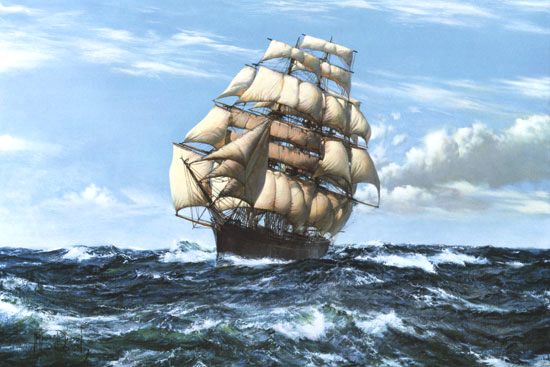
The Cutty Sark
- oil painting by Montague Dawson. When I was a lad queuing for the bus in
Eastbourne to get to Ratton Secondary school, there was an art gallery
opposite the railway station. The above picture was on display in the art
gallery for many thousands of pounds. If I'd had the money I would have
bought it. I'm still captivated by the imagery, though now capable of
painting the scene myself, for me Montague Dawson is the master of
seascapes and tall ships.
MARITIME HISTORY
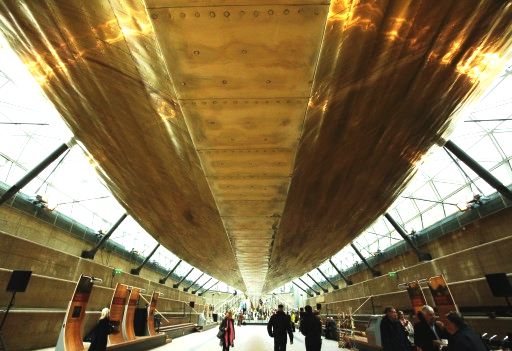
Getting
to the bottom of it - Cutty Sark's lovely gold hull plating
GENERAL HISTORY
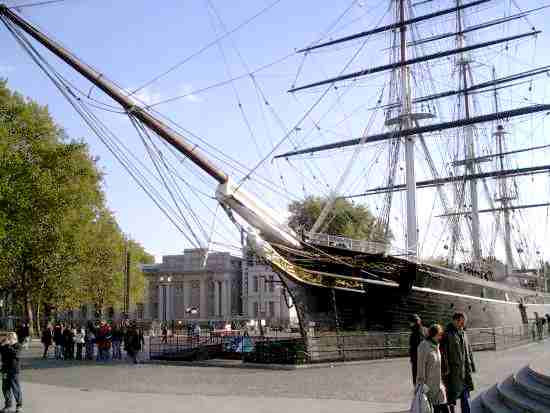
The Cutty Sark
with the Greenwich maritime museum in background 2005
LINKS
and REFERENCE
LINKS
|



















